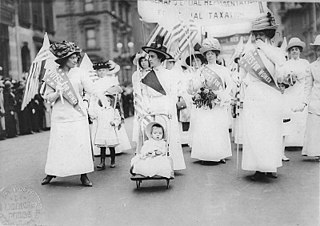
Tomboy is a term used for girls or young women with masculine traits. It can include wearing androgynous or unfeminine clothing and engaging in physical sports or other activities and behaviors usually associated with boys or men.

Femininity is a set of attributes, behaviors, and roles generally associated with women and girls. Femininity can be understood as socially constructed, and there is also some evidence that some behaviors considered feminine are influenced by both cultural factors and biological factors. To what extent femininity is biologically or socially influenced is subject to debate. It is conceptually distinct from both the female biological sex and from womanhood, as all humans can exhibit feminine and masculine traits, regardless of sex and gender.
The sex-positive movement is a social and philosophical movement that seeks to change cultural attitudes and norms around sexuality, promoting the recognition of sexuality as a natural and healthy part of the human experience and emphasizing the importance of personal sovereignty, safer sex practices, and consensual sex. It covers every aspect of sexual identity including gender expression, orientation, relationship to the body, relationship-style choice, and reproductive rights. Sex-positivity is "an attitude towards human sexuality that regards all consensual sexual activities as fundamentally healthy and pleasurable, encouraging sexual pleasure and experimentation." It challenges societal taboos and aims to promote healthy and consensual sexual activities. The sex-positive movement also advocates for comprehensive sex education and safe sex as part of its campaign. The movement generally makes no moral distinctions among types of sexual activities, regarding these choices as matters of personal preference.
"Lipstick lesbian" is slang for a lesbian who exhibits a greater amount of feminine gender attributes, such as wearing make-up, dresses or skirts, and having other characteristics associated with feminine women. In popular usage, the term is also used to characterize the feminine gender expression of bisexual women, or the broader topic of female–female sexual activity among feminine women.
This is an index of articles related to the issue of feminism, women's liberation, the women's movement, and women's rights.
Sex-positive feminism, also known as pro-sex feminism, sex-radical feminism, or sexually liberal feminism, is a feminist movement centering on the idea that sexual freedom is an essential component of women's freedom. They oppose legal or social efforts to control sexual activities between consenting adults, whether they are initiated by the government, other feminists, opponents of feminism, or any other institution. They embrace sexual minority groups, endorsing the value of coalition-building with marginalized groups. Sex-positive feminism is connected with the sex-positive movement. Sex-positive feminism brings together anti-censorship activists, LGBT activists, feminist scholars, producers of pornography and erotica, among others. Sex-positive feminists believe that prostitution can be a positive experience if workers are treated with respect, and agree that sex work should not be criminalized.

Third-wave feminism is a feminist movement that began in the early 1990s, prominent in the decades prior to the fourth wave. Grounded in the civil-rights advances of the second wave, Gen X third-wave feminists born in the 1960s and 1970s embraced diversity and individualism in women, and sought to redefine what it meant to be a feminist. The third wave saw the emergence of new feminist currents and theories, such as intersectionality, sex positivity, vegetarian ecofeminism, transfeminism, and postmodern feminism. According to feminist scholar Elizabeth Evans, the "confusion surrounding what constitutes third-wave feminism is in some respects its defining feature."
Postfeminism is a term popularized by the mass media to describe an alleged decrease in support for feminism from the 1990s onwards. It can be considered a critical way of understanding the changed relations between feminism, popular culture and femininity. The term is sometimes confused with subsequent feminisms such as fourth-wave feminism, postmodern feminism, and xenofeminism.

Female Chauvinist Pigs: Women and the Rise of Raunch Culture is a 2005 book by Ariel Levy that critiques the highly sexualized American culture in which women are objectified, objectify one another, and are encouraged to objectify themselves. Levy refers to this as "raunch culture".

Sexual Politics is the debut book by American writer and activist Kate Millett, based on her PhD dissertation at Columbia University. It was published in 1970 by Doubleday. It is regarded as a classic of feminism and one of radical feminism's key texts, a formative piece in shaping the intentions of the second-wave feminist movement. In Sexual Politics, an explicit focus is placed on male dominance throughout prominent 20th century art and literature. According to Millett, western literature reflects patriarchal constructions and the heteronormativity of society. She argues that men have established power over women, but that this power is the result of social constructs rather than innate or biological qualities.

African feminism includes theories and movements which specifically address the experiences and needs of continental African women. From a western perspective, these theories and movements fall under the umbrella label of Feminism, but it is important to note that many branches of African "feminism" actually resist this categorization. African women have been engaged in gender struggle since long before the existence of the western-inspired label "African feminism," and this history is often neglected. Despite this caveat, this page will use the term feminism with regard to African theories and movements in order to fit into a relevant network of existing Wikipedia pages on global feminism. Because Africa is not a monolith, no single feminist theory or movement reflects the entire range of experiences African women have. African feminist theories are sometimes aligned, in dialogue, or in conflict with Black Feminism or African womanism. This page covers general principles of African feminism, several distinct theories, and a few examples of feminist movements and theories in various African countries.

Human female sexuality encompasses a broad range of behaviors and processes, including female sexual identity and sexual behavior, the physiological, psychological, social, cultural, political, and spiritual or religious aspects of sexual activity. Various aspects and dimensions of female sexuality, as a part of human sexuality, have also been addressed by principles of ethics, morality, and theology. In almost any historical era and culture, the arts, including literary and visual arts, as well as popular culture, present a substantial portion of a given society's views on human sexuality, which includes both implicit (covert) and explicit (overt) aspects and manifestations of feminine sexuality and behavior.

Feminism is aimed at defining, establishing, and defending a state of equal political, economic, cultural, and social rights for women. It has had a massive influence on American politics. Feminism in the United States is often divided chronologically into first-wave, second-wave, third-wave, and fourth-wave feminism.
Slut-shaming is the practice of criticizing people, especially women and girls, who are perceived to violate expectations of behavior and appearance regarding issues related to sexuality. The term is used to reclaim the word slut and empower women and girls to have agency over their own sexuality. Gender-based violence can be a result of slut-shaming primarily affecting women. It may also be used in reference to gay men, who may face disapproval for promiscuous sexual behaviors. Slut-shaming rarely happens to heterosexual men.
Feminist views on sexuality widely vary. Many feminists, particularly radical feminists, are highly critical of what they see as sexual objectification and sexual exploitation in the media and society. Radical feminists are often opposed to the sex industry, including opposition to prostitution and pornography. Other feminists define themselves as sex-positive feminists and believe that a wide variety of expressions of female sexuality can be empowering to women when they are freely chosen. Some feminists support efforts to reform the sex industry to become less sexist, such as the feminist pornography movement.
Neofeminism describes an emerging view of women as becoming empowered through the celebration of attributes perceived to be conventionally feminine, that is, it glorifies a womanly essence over claims to equality with men. It is a term that has come into use in the early 21st century to refer to a popular culture trend, what critics see as a type of "lipstick feminism" that confines women to stereotypical roles, while it erodes cultural freedoms women gained through the second-wave feminism of the 1960s and 1970s in particular.

Rosalind Clair Gill is a British sociologist and feminist cultural theorist. She is currently Professor of Social and Cultural Analysis at City, University of London. Gill is author or editor of ten books, and numerous articles and chapters, and her work has been translated into Chinese, German, Portuguese, Spanish and Turkish.
Feminist activism in hip hop is a feminist movement based by hip hop artists. The activism movement involves doing work in graffiti, break dancing, and hip hop music. Hip hop has a history of being a genre that sexually objectifies and disrespects women ranging from the usage of video vixens to explicit rap lyrics. Within the subcultures of graffiti and breakdancing, sexism is more evident through the lack of representation of women participants. In a genre notorious for its sexualization of women, feminist groups and individual artists who identify as feminists have sought to change the perception and commodification of women in hip hop. This is also rooted in cultural implications of misogyny in rap music.
Fourth-wave feminism is a feminist movement that began around 2012 and is characterized by a focus on the empowerment of women, the use of internet tools, and intersectionality. The fourth wave seeks greater gender equality by focusing on gendered norms and the marginalization of women in society.
White feminism is a term which is used to describe expressions of feminism which are perceived as focusing on white women but are perceived as failing to address the existence of distinct forms of oppression faced by ethnic minority women and women lacking other privileges. The term has been used to label and criticize theories that are perceived as focusing solely on gender-based inequality. Primarily used as a derogatory label, "white feminism" is typically used to reproach a perceived failure to acknowledge and integrate the intersection of other identity attributes into a broader movement which struggles for equality on more than one front. In white feminism, the oppression of women is analyzed through a single-axis framework, consequently erasing the identity and experiences of ethnic minority women the space. The term has also been used to refer to feminist theories perceived to focus more specifically on the experience of white, cisgender, heterosexual, able-bodied women, and in which the experiences of women without these characteristics are excluded or marginalized. This criticism has predominantly been leveled against the first waves of feminism which were seen as centered around the empowerment of white middle-class women in Western societies.











